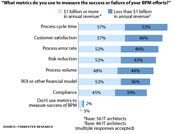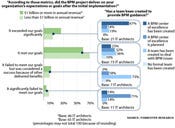The business process management market is heating up, and a new report reveals that centers of excellence are the key ingredient of deployment success.

Business process management (BPM) technology is gaining mainstream adoption, but larger firms and particularly those with BPM centers of excellence are enjoying the greatest success.
These are the key findings of a new report from Forrester Research entitled "The EA View: BPM Has Become Mainstream." The report, written by analyst Ken Vollmer, offers detailed analyses of BPM software adoption, deployment maturity by company size, project focus and even vendor selection. But for those focused on results, the report's key finding is that "having a BPM center of excellence significantly increases the odds of BPM success.
Going Mainstream
By all accounts, the market for business process management suites (BPMS) is on a heady growth curve. Gartner projects the market will reach $5.1 billion by 2011, while IDC and Forrester put that figure at $5.5 billion and $6.3 billion, respectively. But how do these market projections relate to actual adoption within the enterprise? "BPM Has Become Mainstream" offers a more concrete perspective backed by two separate research studies.
Forrester reports that about 60 percent of organizations are already using a BPMS, and another 19 percent plan to do so in the next 12 months. These findings are based on a September 2007 survey of more than 400 North American and European technology decision makers. A separate survey of 164 US- and UK-based enterprise architects, conducted last October, finds that 85 percent of respondents are either actively planning for BPM deployments or already have one or more BPM efforts under way.

"How far have you progressed with your BPM projects?"
(click image for larger view)
Assessing the maturity of BPM deployments, the US/UK study finds that 45 percent or respondents have one or more BPM projects either under way or completed while 42 percent are in the planning stages. What's holding back the remaining 13 percent? Cost and lack of proven benefits or resources are cited as the biggest roadblocks to adoption (see chart at right).
The Payoff in BPM
BPM taking off because "it has become clear to a growing number of organizations that one of the best ways to improve operational performance is through the enhancement of cross-functional business processes," writes Vollmer, adding that technology maturity is also boosting adoption. "Whether an organization is looking to integrate processes, coordinate human tasks, or improve the effectiveness of document processing, there are comprehensive BPM suites that address each of these requirements."

What do you see as the primary benefit of BPM?
(click image for larger view)
Examining the result in more detail, among the 142 respondents who either have or are actively planning a BPMS deployment, the top-three realized gains or hoped-for benefits are increased productivity (24 percent), real-time visibility into key processes (18 percent) and the ability to change processes quickly and easily (15 percent). Other perceived benefits include consistent process execution and process optimization (see chart at right).
The US/UK survey also details BPM adoption by company size, noting that "the status of deployments is similar in the area of planning/research, but larger firms [with $1 billion or more in revenue] have a significant lead over smaller firms in having BPM in production in multiple departments." Larger firms are also more likely to have process modeling, process reporting, process optimization and process redesign efforts under way than are firms with less than $1 billion in revenue.
Measures of Success

"What metrics do you use to measure BPM efforts?"
(click image for larger view)
Process measurability is seen as a key benefit of BPM, so it's no surprise that adopters make a point of measuring the success of BPM deployments. Among large ($1-billion-plus revenue) firms, improvements in process cycle times and customer satisfaction are tied as the leading measures of success, each cited by 57 percent of respondents. Next are reductions in process error rates and risk, each cited by 52 percent of large-firm architects. Other measures of BPM success (see chart at right) include increases in process volumes (at 48 percent of large firms) and improvements in compliance (at 45 percent).
There are obvious connections among these leading metrics. For instance, faster service and reduced error rates undoubtedly lead to improvements in customer satisfaction. Similarly, lower error rates clearly mean less risk for the organization.
The 'Secret Sauce'
Forrester's report dubs centers of excellence as "the secret sauce" on the strength of "dramatic evidence [that they] contribute to higher levels of BPM success." Forrester defines a center of excellence as "a formally appointed and documented body of knowledge and experience on a particular subject area with the goals of providing expertise, managing governance practices, and supporting projects associated with the subject area." As evidence of the impact of these groups, half of the respondents reporting clear and measurable benefits from BPM have related centers of excellence in place while only 4 percent of those reporting no BPM success have such centers. Forrester also finds that firms with BPM centers of excellence are more successful in meeting enterprise-level goals.

"Did the BPM project deliver?"
(click image for larger view)
"Specifically, 67 percent of the enterprises that report their BPM efforts significantly exceeded their goals have a BPM center of excellence," according to the report (see chart at right), while "only 14 percent of the enterprises that report no BPM project success have a BPM center of excellence."
It should be no surprise that centers of excellence are associated with organizational commitment and a standardized approach to guiding process improvement — two key requirements of BPM project success cited by the research firm. While these two qualities can exist with or without a competency center, Forrester concludes that "by establishing a BPM center of excellence, the management team sends a message that it is committed to the success of the process improvement effort, and this helps break down internal barriers for the project team."
It's undoubtedly advice that applies (and a "secret sauce" success factor) in nearly any enterprise-level technology endeavor demanding organizational change.
Forrester's complete "BPM Has Become Mainstream" report offers more detail on BPM deployment demographics and vendor choices as well as advice on center of excellence composition and implementation. For a free download, click here (registration required).
About the Author(s)
You May Also Like







